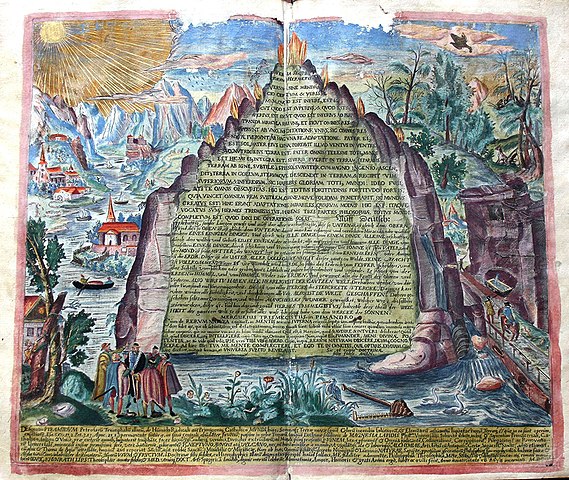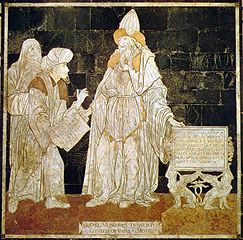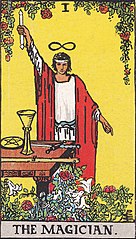As above, so below
"As above, so below" is a popular modern paraphrase of the 2nd verse of the Emerald Tablet, also known as the Smaragdine Tablet or the Tabula Smaragdina, a compact and cryptic Hermetic text, attributed to the legendary figure Hermes Trismegistus, a syncretic combination of the Greek god Hermes and the Egyptian god Thoth. It is understood as a reference to effects of celestial upon terrestrial and also points to structural similarities between macrocosm or cosmos as a whole and the microcosm or human being.
Whole verse in Arabic:
إن الأعلى من الأسفل والأسفل من الأعلى
(That which is above is from that which is below, and that which is below is from that which is above.)
Whole verse in Latin:
Quod est superius est sicut quod inferius, et quod inferius est sicut quod est superius.
(That which is above is like to that which is below, and that which is below is like to that which is above.)
It is good to mention that there is a difference, namely in Latin we have "as" and "like", and in original Arabic it is "from". I don't know if this makes any significant difference in understanding the verse.
In the book, The Kybalion, we read:
"This Principle embodies the truth that there is always a Correspondence between, the laws and phenomena of the various planes of Being and Life. The old Hermetic axiom ran in these words "As above, so below; as below, so above". And the grasping of this Principle gives one the means of solving many a dark paradox, and hidden secret of Nature. There are planes beyond our knowing, but when we apply the Principle of Correspondence to them we are able to understand much that would otherwise be unknowable to us. This Principle is of universal application and manifestation, on the various planes of the material, mental, and spiritual universe it is an Universal Law. The ancient Hermetists considered this Principle as one of the most important mental instruments by which man was able to pry aside the obstacles which hid from view the Unknown. Its use even tore aside the Veil of Isis to the extent that a glimpse of the face of the goddess might be caught. Just as a knowledge of the Principles of Geometry enables man to measure distant suns and their movements, while seated in his observatory, so a knowledge of the Principle of Correspondence enables Man to reason in telligently from the Known to the Unknown. Studying the monad, he understands the archangel."
Emerald Tablet
The Emerald Tablet also known as the Smaragdine Tablet (latin: Tabula Smaragdina, from the Arabic: لَوْح الزُّمُرُّذ, Lawḥ al-zumurrudh), is an ancient Hermetic text document that contains the essence of the alchemical teachings in a compact and cryptic form. It was highly regarded by Islamic and European alchemists as the foundation of their art. The history of the Emerald Tablets is strange and beyond the belief of modern scientists. An ancient text was supposedly carved into emerald or green stone, though the actual tablets have never been found. The earliest known version of the Emerald Tablet on which all later versions were based is found in Sirr al-khalīqa wa-ṣanʿat al-ṭabīʿa or The Secret of Creation and the Art of Nature.

Engraved image of the "emerald tablet" from Amphitheatrvm sapientiae aeternae, solivs verae, 1609, by Heinrich Khunrath (1560-1605)
Translation of Arabic version:
0) Here is that which the priest Sagijus of Nabulus has dictated concerning the entrance of Balinas into the hidden chamber... After my entrance into the chamber, where the talisman was set up, I came up to an old man sitting on a golden throne, who was holding an emerald table in one hand. And behold the following - in Syriac, the primordial language- was written thereon:
1) Here (is) a true explanation, concerning which there can be no doubt.
2) It attests: The above from the below, and the below from the above -the work of the miracle of the One.
3) And things have been from this primal substance through a single act. How wonderful is this work! It is the main (principle) of the world and is its maintainer.
4) Its father is the sun and its mother the moon; the
5) wind has borne it in its body, and the earth has nourished it.
6) the father of talismen and the protector of miracles
6a) whose powers are perfect, and whose lights are confirmed (?),
7) a fire that becomes earth.
7a) Separate the earth from the fire, so you will attain the subtle as more inherent than the gross, with care and sagacity.
8) It rises from earth to heaven, so as to draw the lights of the heights to itself, and descends to the earth; thus within it are the forces of the above and the below;
9) because the light of lights within it, thus does the darkness flee before it.
10) The force of forces, which overcomes every subtle thing and penetrates into everything gross.
11) The structure of the microcosm is in accordance with the structure of the macrocosm.
12) And accordingly proceed the knowledgeable.
13) And to this aspired Hermes, who was threefold graced with wisdom.
14) And this is his last book, which he concealed in the chamber.
Further reading and references:
- Emerald Tablet - Wikipedia
- Emerald Tablet of Hermes
- Various Pieces on the Emerald Tablet
- The Emerald Tablet of Thoth/Hermes - ROBERT SEPEHR - YouTube
- The Emerald Tablet of Hermes Trismegistus - Origins History and Meaning of the Famed Text of Alchemy - YouTube
- Alchemy - Isaac Newton & the Emerald Tablet of Hermes Trismegistus - YouTube
Hermes Trismegistus
Hermes Trismegistus (from ancient greek: Ἑρμῆς ὁ Τρισμέγιστος, "Hermes the Thrice-Greatest", classical latin: Mercurius ter Maximus) is a legendary author of many works embodying magical, astrological, and alchemical doctrines. The ancient Greeks identified their god Hermes with the Egyptian Thoth (the two gods were worshiped as one) and gave him the epithet Trismegistus, or "Thrice-Greatest", because he had knowledge of three parts of the wisdom of the universe: alchemy (the operation of the sun), astrology (the operation of the stars) and theurgy (the operation of the gods).

Floor inlay in the Cathedral of Siena Russian: Hermes Mercurius Trismegistus, contemporary of Moses, on the left pages of the book
Actually he was credited with the creation of a number of branches of knowledge: law, magic, philosophy, religion, science and writing. He gave to the Egyptians their arts and sciences. In Islamic tradition, he is considered as the builder of the pyramids in Giza, Egypt. There is a vast literature in Greek ascribed to him. The cited number of works ranges from 20,000 (Seleucus) to 36,525 (Manetho). Clement of Alexandria knew of 42 "indispensable" books, written by Hermes. His work layed the basis of various philosophical systems known as Hermeticism. The figure of Hermes Trismegistus can also be found in both Islamic and Baháʼí writings, in which has been associated with the prophet Idris.
Further reading and references:
- Hermes Trismegistus - Wikipedia
- Hermes Trismesgistus - Glorian
- Who was Hermes Trismegistus? | The Hermetica Explained - YouTube
- Hermes Trismegistus | Ancient Greece Revisited - YouTube
- Hermes and Hermeticism
- ANCIENT EGYPT : Hermes
- Hermetism and Hermeticism: An Introduction
- Orientation of the Hermetic Philosophy - Manly P. Hall (Doctrines of Hermes Trismegistus) - YouTube
- Manly P. Hall's The Life & Writings of Thoth Hermes Trismegistus - YouTube
- What is Hermeticism? - YouTube
Microcosm and Macrocosm
"To understand correctly the meaning of the words Alchemy and Astrology, it is necessary to understand and to realize the intimate relationship and identity of the Microcosm and Macrocosm, and their mutual interaction."
Macrocosm comes from ancient Greek word μακρός (makrós, "great", "long") + κόσμος (kósmos, "universe", "order").
Microcosm comes from ancient Greek word μικρός (mikrós, "small") + κόσμος (kósmos, "universe", "order").
When we mention Astrology, we must also mention Macrocosm and Microcosm, because this somehow explains relation between us and all the existence around us. This concept is found in different philosophies and beliefs from all around the world, especially in the systems of Vedic, classical Greek, and Gnostic thought, also in ancient Iranian thought and in ancient China. It deals with idea that there is a corresponding similarity in pattern, nature or structure between individual human being and the universe. It views the individual human being as a microcosm or little world, whose composition and structure correspond to that of the macrocosm or great world - Cosmos. The microcosm–macrocosm analogy was adopted by a wide variety of medieval thinkers. The concept of microcosm was known in Arabic as ʿālam ṣaghīr, in Hebrew as olam katan, and in Latin as microcosmus or minor mundus. In Renaissance, it was central to the new medical theories.
Some of the examples:
7 planets - 7 spheres - 7 bodies - 7 glands
4 elements - 4 seasons - 4 bodily humors
Lunar cycle - menstrual cycle
Earth cycles - circadian cycles
Further reading and references:
- Patterns in Nature: Microcosm - Macrocosm - YouTube
- From Microcosm to Macrocosm - Complete Documentary - YouTube
- Atom: The Key To The Cosmos (Jim Al-Khalili) | Science Documentary | Reel Truth Science - YouTube
- (PDF) Harmony exists universally from Microcosm to Macrocosm: Peaceful Coexistence is the Nature of everything
- THE CONCEPTUAL FOUNDATIONS OF THE HINDU COSMOLOGICAL VISION
Melothesia
Melothesia is the science of charting zodiac influences on the human body. This connected astrology with medical techniques and associated various parts of the body, diseases, and drugs with the nature of the sun, moon, planets, and the 12 astrological signs. These associations and influences were believed by both educated elite and average people for centuries. This was presented in diagram called Zodiac Man (Homo signorum in Latin). One branch of astrology, so called medical astrology, is based on melothesia. It was mentioned by Marcus Manilius in his epic poem Astronomica.
Political cosmology
Plato, an ancient Greek philosopher, explores the concept of political cosmology in his work "Timaeus." In this dialogue, Timaeus, a Pythagorean philosopher, presents a cosmological account of the creation of the universe, including a discussion on the nature of the state and its connection to the cosmic order.
Cosmic Order
Plato begins with the idea that the cosmos is a product of reason, intelligence, and divine design. The Demiurge, a divine craftsman, shapes the material world based on eternal Forms or Ideas. The cosmos, according to Plato, is a perfect and ordered entity.
Three Components of the Soul
Plato introduces a tripartite division of the soul, consisting of reason, spirit, and desire. This division serves as the foundation for his political theory.
Microcosm and Macrocosm
Plato establishes a connection between the individual and the state by drawing parallels between the microcosm (individual) and macrocosm (state or society). He suggests that the order and harmony present in the cosmos should be reflected in the organization of the state.
Social Classes
Plato proposes a stratified society based on the three components of the soul. The rulers or guardians, representing reason, are responsible for governing the state. The auxiliaries, embodying spirit, serve as the military and protectors of the state. The producers, driven by desire, are involved in economic activities.
Philosopher-King
Plato introduces the concept of the philosopher-king, an enlightened ruler with a deep understanding of the Forms and the Good. According to him, the ideal state would be one where philosophers rule, ensuring that wisdom guides political decisions.
Education
Plato emphasizes the importance of education in shaping the character of individuals and, by extension, the state. The education system in Plato's ideal state is designed to nurture the best qualities in each individual, leading to a harmonious and just society.
Guardianship of Laws
Laws play a crucial role in Plato's political cosmology. He argues that laws should reflect the cosmic order and serve as a guide for citizens in leading a virtuous life. Laws are considered necessary for maintaining order and justice in the state.
Civic Virtue
Plato's political cosmology promotes the idea of civic virtue, where individuals prioritize the common good over personal interests. The state, in turn, becomes a reflection of the harmonious cosmic order when citizens embody virtues such as wisdom, courage, and temperance.
In summary, Plato's political cosmology in "Timaeus" integrates his metaphysical views on the cosmos with his vision of an ideal state. The connection between the cosmic order and the political organization underscores Plato's belief that a just and harmonious society mirrors the perfection found in the divine and intelligible realm.
